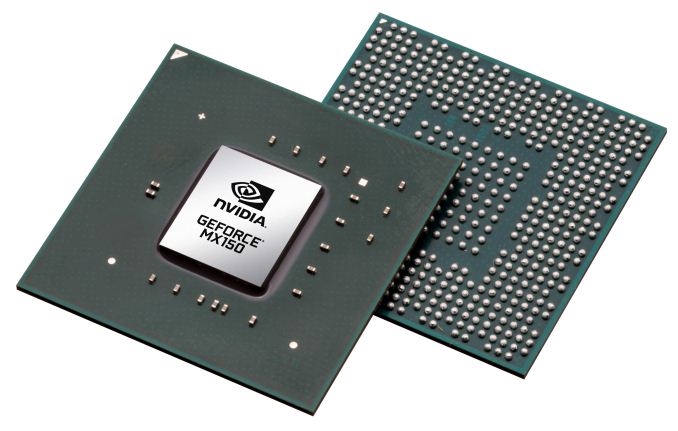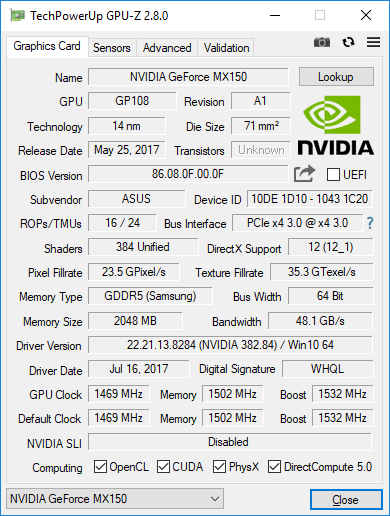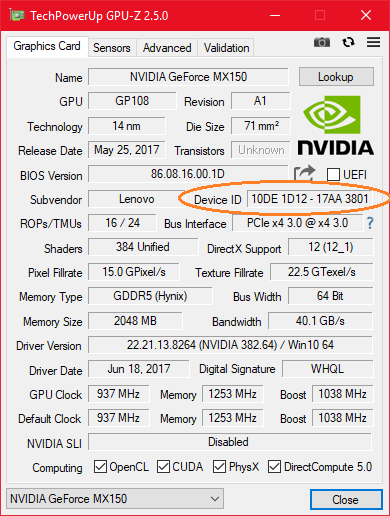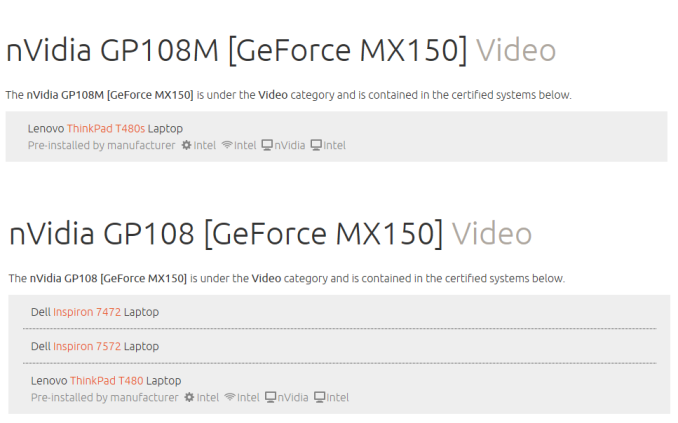NVIDIA Silently Rolls Out Slower, Lower TDP GeForce MX150 for Ultrabooks
by Nate Oh on March 23, 2018 2:00 PM EST
This week, Notebookcheck reported their findings of a second version of the GeForce MX150 – the newest version sporting lower base, boost, and memory clockspeeds versus the original SKU. Annoyingly however, these two versions are not being differentiated in advertising by NVIDIA or by OEMs.
Diving into matters, it looks like this second MX150 is designed to be a lower performing, lower TDP version for smaller ultrabooks. Notebookcheck cited their GPU-Z results as showing two different PCI IDs, comparing the standard ‘1D10’ and variant ‘1D12’ to find a default clockspeed difference of 36% for base, 17% for memory, and 32% for boost. In turn, they cited 3DMark tests in estimating a 20 to 25% performance drop for the “1D12’ MX150, where a number of 13 inch ultrabooks had this variant but was not disclosed.

 Notebookcheck's GPU-Z reports, with standard '1D10' N17S-G1-A1 GeForce MX150 in the Zenbook UX430UN (left), and slower '1D12' N17S-LG-A1 GeForce MX150 in the IdeaPad 320s-13kbr (right)
Notebookcheck's GPU-Z reports, with standard '1D10' N17S-G1-A1 GeForce MX150 in the Zenbook UX430UN (left), and slower '1D12' N17S-LG-A1 GeForce MX150 in the IdeaPad 320s-13kbr (right)
Further investigation on our part does reveal that there is a documented understanding that they are different parts, at least from an OEM perspective. By way of the official Ubuntu Certified hardware database, PCI ID ‘1D10’ is documented as the ‘GP108’ MX150 variant of the ThinkPad T480, while ‘1D12’ is recorded as the ‘GP108M’ variant of the ThinkPad T480s. In this case, although ‘GP108’ and ‘GP108M’ may not be NVIDIA’s own terminology, the Ubuntu Certified process involves OEMs directly working with Canonical to test their hardware. Canonical’s differentiation strongly implies that the OEMs are aware of MX150 variant.
Continuing with the ThinkPad as the prime case study, each product page has no indication of any difference in discrete graphics adapters, though the T480s is the thinner laptop variant. And while different cooling designs of laptops will change the exact clocks of the same GPU, the different PCI IDs and certifications suggest that this a vendor-side variant undisclosed to consumers.
In total, Notebookcheck also noted the presence of the slower MX150 in the ZenBook UX331UN, ZenBook UX331UA, Mi Notebook Air 13.3, Envy 13, and IdeaPad 320s. And a cursory look at The PCI ID Repository again corroborates the idea of the two corresponding ‘1D10’ and ‘1D12’ PCI IDs, with a GP108 Quadro variant in the P500. From the January/February dates of the Ubuntu certification and PCI ID Repository entries, we can say this development has been ongoing for several months at the least.
The engineering practicality isn’t in doubt here – constrained cooling designs of ultra-thin laptops necessitate lower discrete GPU clocks – but it appears that consumers were not notified of an explicit product difference. This is as juxtaposed with the OEM situation, where OEMs and/or NVIDIA did explicitly communicate to Canonical for the purposes of Ubuntu hardware certification. And while it is true that mobile and low-end (and especially mobile low-end) GPUs receive very little in terms of public documentation or vendor disclosure, this is why a lack of product transparency is a losing situation all around.
Though we only came across the Ubuntu Certified database entries after reaching out, NVIDIA has declined to comment on the matter. However, with what we have collated, there seems to be little reason to doubt the undisclosed slower MX150 variant.











40 Comments
View All Comments
mr_tawan - Saturday, March 24, 2018 - link
I'd hazard guess that MX130 would be outperformed and may draw power. It is 940mx in disguise after all.oRAirwolf - Friday, March 23, 2018 - link
I honestly don't understand the point of these gpus. The performance difference between an mx150 and regular Intel gpus is so minimal that you really aren't going to get any additional benefit out of them. 1.2 teraflops at the high end is really not enough to play any modern games. All it's doing is draining extra power and providing very little in return. It seems like more of a selling point to just have an Nvidia logo sticker on a laptop than any meaningful performance difference.Retycint - Friday, March 23, 2018 - link
That's not true though. A normally clocked MX150,such as in the HP Spectre x360, typically offers anywhere from 100 to 500% of the performance of the Intel UHD620, depending on the game. Even the under clocked variants in the Zenbook 13,for example, handily out performs the UHD620. So I don't see how an MX150 could possibly be uselesskfishy - Friday, March 23, 2018 - link
I have a NUC with Skylake Iris graphics with eDRAM and also a laptop with MX150, the MX150 handily beats even Intel GPU with eDRAM.kfishy - Friday, March 23, 2018 - link
Oh, and not to mention that the TDP of the integrated GPU counts towards the entire chip TDP so when you game it’s throttle throttle throttle.Alexvrb - Sunday, March 25, 2018 - link
If it's an Intel machine, as Retycint said it beats the everliving SNOT out of the iGPU. Especially on the kind of mid-tier chips the MX150 tends to ship with. So for Intel-based systems I totally get it.With that being said, a Ryzen 2700U with decent RAM is fairly competitive with even a full-clock MX150, at an incredibly low TDP (even if an OEM up-TDPs to 25W it still undercuts total CPU/GPU power by a LOT). I hope we see more Ryzen APU designs trickling down to more price points.
mr_tawan - Monday, March 26, 2018 - link
While it might not be worth gaming on these GPUs, mobile GPUs can help with some 2D graphics app (ClipStudio, Photoshop, Mischief, etc.). Intel's iGPU tends to choke on these apps, especially on 2K screen and above. That's why some manufacturer put GPU on business laptops.mathew7 - Monday, March 26, 2018 - link
You base your data on GPU-only workload. Add CPU workload and intel's IGP get neutered because of chip power/TDP limitations. A friend of mine had a laptop with additional radeon GPU, which gave 8fps in Furmark compared to IGPs 9fps. But when I also started 2 CPU threads (Furmarks build-in CPU stress), IGP went to 3fps while radeon stayed at 8fps. That is the advantage of discrete GPU.f4tali - Friday, March 23, 2018 - link
I'm in the market for one of these or similar but this whole category is downright depressing atm...- Been seeing a few 940mx pop up with 8th gen Intel :(
- Only Ryzen option is the ACER in my country and costs almost $990! (800 Euro). And that's for the 2500U.
- MX150 options here are so extortionately priced that I may as well go for something with a GTX 1050.
Kinda overkill for me though for just a bit of SETI crunching and maybe the odd ol' game. TBH I really wanted to try the Ryzen but with only one option at such a ridiculous price....
eva02langley - Monday, March 26, 2018 - link
If I were you, I would wait until something more interesting is released on Ryzen mobile.